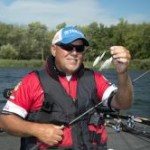Fine-Tuning Your Spinnerbait Selection
from The Fishing Wire
Among his contemporaries, Matt Herren has long been considered one of the best spinnerbait fishermen competing on the Bassmaster® Elite Series, but all are surprised to learn the Yamaha Pro actually keeps very few of the popular blade-type lures in his boat.
Instead, Herren carries boxes of spinnerbait components, including blades, skirts, and heads, and makes his lures on the water as he needs them.
“I wouldn’t have enough room in my boat to carry all the different spinnerbaits I might want during a tournament,” laughs Herren, “so I keep boxes of parts in different colors and weights and put them together as the conditions dictate. It only takes a minute or so to make one, so I’m really not losing much time at all, and I can have exactly what I want.”
Herren likes a double willow leaf spinner in autumn, but is always ready for a quick change as needed.Herren believes spinnerbaits are far more specialized than most anglers realize, and he uses several criteria to fine-tune his selection, including water temperature, water color, and the type of structure and cover he will be fishing. During the autumn months, for instance, he normally fishes spinnerbaits with double willow leaf blades, or a combination of Colorado and willow leaf blades.
“Fall is perfect for spinnerbaits because the primary bass forage this time of year is shad, and with willow leaf blades I can match the size and even the color of that forage very closely,” Herren explains. “Normally, the water is clear in the fall, too, so if I’m fishing 10 feet deep or less, I’ll make a spinnerbait with double willow leaf blades, because those blades keep the lure from sinking very deep. If I want to fish deeper, I’ll replace the front willow leaf with a more rounded Colorado-style blade so the lure will sink.
“I believe a lot of fishermen overlook the importance of blade size and color, but at times these can be critical in determining whether bass hit or not. I’ve experienced many days where a slight blade change made all the difference in the world. That’s why I prefer to make my spinnerbaits while I’m fishing.”
Chunky bass like this one are chasing shad in fall, and the flashing blades of a spinner are a good imitation.The Yamaha Pro’s favorite blade color in clear water this time of year is copper, since it isn’t as bright as gold or nickel, but still provides enough flash to attract bass. In his component boxes, Herren has not only these three blade colors, but also white and chartreuse in a variety of sizes.
“My blade and color choices now as summer changes into fall are quite a bit different than they are in the spring,” points out Herren. “In the spring, when the water is often more stained and the temperature is cooler, I want more vibration from my spinnerbait blades, so I really prefer the more rounded Colorado blades. In extremely dingy water, I’ll even make spinnerbaits with double Colorado blades. You don’t find many spinnerbaits like this in the tackle stores, but they’re a major part of my fishing.
“Depending on how deep I want to fish, I’ll make them in weights ranging from as light as ¼-ounce to as heavy as 1 ½-ounces. Then, as the water temperature gradually warms, I’ll switch one of those Colorado blades for an elongated willow leaf. For me, it’s easier to make the exact spinnerbait I want rather than try to carry so many with me and then try to find it.”
Herren says he’d rather make up his own spinnerbaits as needed, fine-tuning them to match whatever a tournament throws at him.Herren’s ability to make his own spinnerbaits while on the water has also allowed him to fine-tune his presentations, as well. Few think of making vertical presentations with spinnerbaits, for example, but this is one of the Yamaha Pro’s favorite fall techniques. Instead of casting, he makes short underhand pitches and lets the lure free-fall straight down on a slack line. He uses this technique around rock bluffs, at the ends of laydowns, and even around boathouse pilings.
“I’ve a lot of caught bass doing this with ¼-ounce spinnerbaits with a single large size 4 blade, and also with heavier ¾-oz. spinnerbaits with size 4 ½ and 5 blades,” continues the Yamaha Pro, “blade and weight combinations you’ll never find on the store shelves.
“Building my own spinnerbaits has allowed me to experiment like this and not only create my own favorite combinations, but also to learn to fish the lures a little differently than the other tournament pros, and over the years it’s really paid off for me.”



